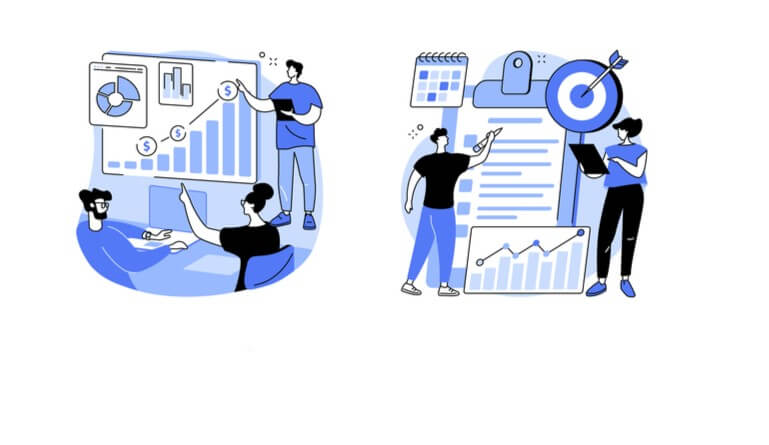A constant philosophy within your organization should be to build and promote an employee experience that leads to permanence, profitability, and high employee engagement. Rather than treating employee engagement as a one-time event, the employee life cycle model views it as a planned experience that is braided throughout the path of every employee in your company.
The employee life cycle model is used to identify and communicate the many and most essential stages that an employee experiences as they interact with their employer. Attraction, recruitment, onboarding, development, retention, and separation are the major six distinct stages at work. These stages are further segmented into more microscopic stages to control and regulate the employee life cycle effectively.
Below are the 12 stages of the Employee Life Cycle, which can be used to assess an employee’s progress about the organization’s growth.
-
Apply the Law of Attraction
To compete in today’s competitive personnel market, attracting the right people at the onset of the employee life cycle is critical. There is a lot of talent out there. Present generation employees are becoming increasingly selective about where they work.
Employees are your finest brand ambassadors. By fostering a positive business culture, you enhance the likelihood that your current employees will spread the word about how amazing it is to work with you. One of the most important aspects of this is listening to and acting on feedback. Using social media and sites like Glassdoor, actively and regularly manage the company’s online reputation.
The employer must concentrate on attracting the right candidate. To gravitate the rich talent, one must create an employer brand that is consistent with the company vision, mission, and values. Make sure that the company is seen as a fantastic place to work.
-
Interview: a productive interpersonal communication
The interviewing process is a crucial component of the employee life cycle. During the interview, both the organization and the candidate should ask questions to get a feel of if the role is a good fit.
While most businesses utilize interviews to qualify candidates, it’s as important for the interviewee to assess whether the job and company culture are a suitable fit for what they’re looking for in a job or career, and the employer must be able to help them in doing so during the interview.
-
Recruit the Best Fit
The recruiting life cycle starts with a requirement, for a candidate to perform a specific task and ends with the candidate being employed or placed effectively. Employee referral is one of the finest recruitment strategies for businesses.
Besides that, internships, recruitment events, social media ads, and job portals are some of the channels to execute smooth recruitment. It includes everything from the moment company decides they need a new employee to the onboarding procedure for the new job.
Existing employees are often the most effective hiring screen. As professionals to help, they are likely to know people who would be a good fit for the company.
-
Onboard Candidates to Align their goals with the company goals
It is vital to successfully onboard new employees. To make sure your protocols are in place for the new employee onboarding process, ask for and listen to feedback from the minute they start. Make use of technology that allows you to easily collect their feedback throughout the employment life cycle.
Make a clear outline of the company expectations. It’s critical to walk each employee through your expectations for them, as well as why they’re critical to the company’s success.
Employee training and onboarding questionnaires can be used to collect and act on feedback. Improve the employee journey by using this employee insight. New hires can provide a new viewpoint to your company’s operations. Listening to employees at this time in their careers will also allow you to address minor concerns before they become larger difficulties later.
It’s critical that you sit down with the new employee in the first few days and go over your company’s values and mission, as well as what they all represent. Inquire about your recruit’s feelings about the values and if they have any questions.
-
Engagement saves the employee from monotonous work and boredom
Once the initial excitement of a new job wears off and they settle into a routine, workers may become bored. Employee engagement and a good corporate culture can assist your staff remain enthusiastic about their work daily. Employees that are engaged are more productive and tend to stay in their positions for longer periods.
-
Employee Development
Employees require fresh challenges to maintain their learning and growth once they have established themselves in the company and rooted themselves. This inspires them, resulting in increased engagement and production. Employees who don’t feel progression are more likely to look for work elsewhere, which hurts your bottom line and causes disruption when they go.
Many firms are abandoning the yearly performance review, similar to the annual employee survey because it is just not regular or personalized enough to meet their needs and create true information.
In addition to this keep collecting feedback more frequently to demonstrate that the company is acting on employee insight to assist develop the workforce.
Every employee should be encouraged and supported to create a professional development action plan that will help them grow their skills and boost their prospects of progression. Offer to assist them in completing this task together or provide a template for the entire staff to use to create their simple plan. Employees that learn on their own time should be rewarded.
-
Retention
Employee retention is the seventh stage of the employee lifecycle. This is where you concentrate your efforts on retaining your best employees and ensuring that they are both satisfied and challenged in their work.
In this regard, the positive business culture has a significant impact. A bad corporate culture will undoubtedly result in high employee turnover and the costs associated with having to replace employees frequently.
To meet today’s employee life cycle problems, employers will need to start a conversation and obtain feedback regularly via pulse surveys and always-on feedback.
-
Recognition is a rewarding technique
The main reasons why someone goes to work every day are most likely a steady paycheck and good benefits but going a step further with regular employee recognition can boost employee happiness and commitment to the team. Encouraging managers to recognize good work and providing workers with a way to thank their co-workers can be beneficial to all parties involved.
-
Offboarding
When an employee leaves, it is hoped that they do so amicably. Instead of taking someone out of the building when they give two weeks’ notice, arrange for a smooth transition of responsibilities, cross-training for anyone who might need to effectively take over a project or task, and final payroll and benefits preparation.
-
Separation
Employees should leave your firm with nice recollections and good intentions for their co-workers in an ideal situation. Take the time to learn why the employee is leaving and obtain honest input on what you can do to make the organization a better place to work in the future to boost your future performance.
You might want to host a cordial goodbye lunch or happy hour to honor their time at the firm once you’ve taken care of items like network account access, keys, and company assets.
-
Exit Formalities
The life cycle of the majority of employees eventually comes to an end. Employees may leave for a variety of reasons, including retirement, new employment, and family or personal reasons. The de-boarding procedure must be as strategic as your onboarding procedure.
When a team member leaves, it can have an impact on the rest of the team, and it is the manager’s or HR professional’s responsibility to ensure that the person who is leaving does so in a way that does not disturb the entire firm.
When employees depart, many businesses ignore listening to them. Yet, this is a critical element of the employee life cycle and provides an opportunity to obtain honest feedback through employee exit interviews.
Make sure you manage exit interviews appropriately and professionally, analyzing the insight supplied by departing employees. This information could assist in making changes to improve employee retention and employer branding.
Demonstrating that you are still listening at this point in the employee life cycle demonstrates your commitment to employee engagement throughout the journey.
-
Alumni
The business world is dynamic and interconnected, so an employee’s departure does not necessarily mean the end of the relationship. Past employees may return to work, work for a customer, or be asked for their opinion on their company by potential applicants in the future.
Make sure not to overlook this stage of the employee life cycle(1) and utilize technologies like social media and online communities to stay in touch with former employees and hear their comments.
Businesses must guarantee that they are concentrating on the employee life cycle, as well as mapping and comprehending the employee journey. Employees provide various sorts of feedback based on where they are in the employee life cycle, so be prepared to listen.
Create an employee life cycle chart, get feedback, and use the information to enhance your operations. Invest in employee life cycle management software to support the collection and implementation of feedback. You’ll be able to better engage and retain your employees in the long run.
Final Thought
An employee lifecycle model is a useful tool for visualizing and planning each stage of an employee’s interactions with the firm. It is possible to attract and retain a fantastic team by focusing on doing the best you can at each stage.





